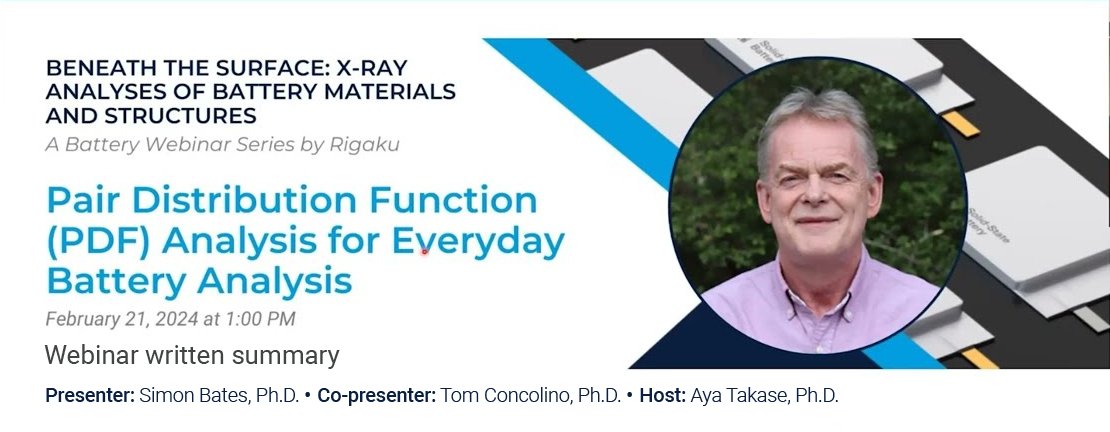Beneath The Surface: X-ray Analyses of Battery Materials and Structures
3. Pair Distribution Function (PDF) Analysis for Everyday Battery Analysis

This is a written summary of a live webinar presented on February 21, 2024. The recording and resources are available on the recording page.
Presented by:
Webinar summary
The webinar, part of a series focused on X-ray analysis of battery materials, provided an in-depth exploration of how X-ray total diffraction and PDF techniques can yield atomistic-level insights into battery materials, particularly lithium-ion cathode structures. The session focused on the limitations of traditional Bragg diffraction-based crystallography for battery analysis and made a compelling case for embracing PDF methods to understand dynamic structural changes during battery cycling and aging.
Using NMC-type (nickel-manganese-cobalt) cathode materials as the core example, Simon explained that while traditional crystallography is useful for identifying average atomic positions within a highly symmetrical lattice, it is far too rigid to accurately model real-world materials where lithium ions are mobile and structural disorder increases over time. In contrast, PDF analysis, grounded in Debye scattering theory, considers all atom-atom pair correlations, allowing researchers to track local structural distortions, lithium diffusion channels, and occupation numbers with high precision. He introduced both small box and big box modeling approaches—where the former uses simplified unit cells and the latter relies on large-scale reverse Monte Carlo simulations involving thousands of atoms—to extract meaningful structural parameters from PDF data.
One key focus was on the significance of lithium mobility within the cathode lattice and the critical nature of channel width between cobalt layers. Simon demonstrated how PDF could precisely quantify these features, with peak positions in the PDF corresponding directly to specific atom-atom distances like Co-Co or Li-O. He emphasized that as batteries cycle, these channels can collapse or become occupied by transition metals such as nickel, triggering irreversible phase changes like the rock salt transformation, which severely degrades battery performance. Remarkably, PDF techniques could detect these early-stage degradation signatures even after just five charge-discharge cycles.
The session included detailed examples using both pristine and cycled NMC 523 materials, collected on multiple Rigaku instruments under various configurations. Simon compared the effects of cycling on lattice disorder, lithium occupation, and cobalt layer spacing. Results revealed that lithium mobility did not drastically change with early cycling, but cobalt lattice disorder increased, and lithium layer occupation rose—an unexpected observation explained by transition metal ions migrating into the lithium layers. This interpretation was supported by high-resolution electron diffraction (XtaLAB Synergy-ED) data, which showed abnormal electron density within the lithium layers, pointing to the nucleation of a destructive rock salt phase.
Throughout the talk, Simon advocated for the practicality and accessibility of PDF analysis using modern software tools like SmartLab Studio II and PDF GUI, highlighting that much of the complex data processing—such as Fourier transforms, background subtraction, and normalization—has been automated. He encouraged battery researchers to adopt PDF methods not only for advanced failure analysis but also for routine characterization of new cathode materials. The talk closed by reinforcing the broader applicability of PDF to amorphous materials, solid electrolytes, and solid-state anodes, offering a transformative perspective on structural analysis in battery science.
Key questions answered in the webinar
-
PDF analysis, also known as pairwise distribution function analysis, is an X-ray analysis technique that provides detailed atomistic-level insights into materials, particularly useful for understanding battery performance. It's based on Debye diffraction theory, where each atom-atom pair scatters coherently within itself, allowing for the analysis of individual atom pair relationships and local atomic arrangements. This is in contrast to traditional crystallography, which relies on Bragg diffraction theory and focuses on the average, long-range ordered structure of a material.
Traditional crystallography models define a crystal structure based on a small asymmetric unit cell and symmetry operators, often leading to an idealistic and overly constrained view, especially when trying to understand phenomena like lithium mobility in battery materials. For instance, in a crystallographic model, lithium's position might appear fixed by symmetry, even though it's known to move freely in channels. PDF, however, is additive and can delve into the "nitty gritty" of local atomic movements, disorder, and composition changes, making it a more realistic model for complex and dynamic materials like battery cathodes during cycling.
-
PDF analysis is crucial for understanding lithium-ion battery cathode materials because it can provide atomistic-level insights into issues that lead to battery failure and lack of longevity, such as the aging and degradation of cathode materials. By examining atom-atom pair relationships, PDF can reveal:
- Lithium mobility and channel width: It can directly determine the width of the channels through which lithium ions move, a critical design parameter for effective cathode materials. Traditional crystallography often overlooks the dynamic nature of lithium within these channels.
- Disorder and degradation: PDF can quantify different types of disorder within the material, including point defects (e.g., atomic vibrations, temperature effects) and correlated motion between atoms (e.g., phonons). This helps identify changes that occur during charge/discharge cycling, such as the collapse of lithium channels or the nucleation of detrimental phases (e.g., rock salt transformation).
- Compositional effects: It allows for fine-tuning the composition of cathode materials and understanding the impact of doping on longevity and optimization. For example, changes in material composition (like NMC) can lead to lattice expansion and increased channel width, which PDF can precisely track.
-
From PDF data, several key parameters can be extracted to characterize battery material behavior:
- Peak position: Similar to powder diffraction, PDF allows identification of peak positions, which correspond to specific atom-atom bond distances (in angstroms). For instance, the cobalt-cobalt distance can directly indicate the channel width in NMC-type materials.
- Sigma (σ): This parameter describes the uncertainty or range of positions an atom occupies around its defined position. A higher sigma indicates greater atomic disorder or movement (e.g., vibration). For lithium, a higher sigma suggests increased mobility, while for rigid frameworks like cobalt, a lower sigma indicates a more ordered structure.
- Rate: This parameter characterizes the increase in peak broadening (sigma) as a function of distance. A rate of zero indicates a highly ordered crystalline material, while a rate closer to one suggests complete disorder. This helps understand the extent of correlated atomic motion and structural degradation.
- Occupation number: This indicates the average amount of a specific atom present at a given site. A decrease in occupation number for lithium, for example, suggests lithium leaving the lattice during discharge. Conversely, an increase might indicate foreign atoms (e.g., nickel, manganese, cobalt) migrating into the lithium layer, leading to material degradation.
-
Atomistic models are essential for complex PDF analysis, and there are two main types:
- Small box models: These typically use a unit cell (for crystalline materials) or a molecular unit (for amorphous materials) as the basic building block. Atoms within this small box can be moved with or without symmetry constraints to fit the experimental PDF data. Programs like PDF GUI are commonly used for this. Small box models are generally effective for well-ordered crystalline materials and provide parameters like sigma and occupation numbers based on average structures.
- Big box models: These models involve thousands of atoms in a larger simulated box, which are then refined using techniques like reverse Monte Carlo. They allow for more detailed and physically realistic modeling, especially for materials with random disorder or complex local structures. Big box models can generate maps of specific atom-atom relationships and provide insights into disorder rates and overall structural changes that might be difficult to capture with smaller, more constrained models. While computationally more intensive, they can offer a more accurate representation of highly disordered or alloyed battery materials.
-
Bond Valence Calculations (BVS) are a predictive analytical tool used in conjunction with crystal structures of novel battery materials. They help determine the mobility or "degrees of freedom" that lithium (or other mobile ions) has within a given structure. BVS calculations are based on the valence state (e.g., Co³⁺, Li¹⁺, O²⁻) and ionic radius of the constituent atoms. By analyzing the energetic satisfaction of valence and bonding relationships, BVS can identify free pathways, such as channels or layers, through which lithium can move.
The relevance of BVS to battery materials lies in its ability to predict how effective a material will be as a cathode or solid electrolyte. The presence and width of these channels are critical design parameters. If the channels are too narrow or collapse (e.g., due to lithium extraction leading to a "rock salt transformation"), the mobility of lithium is hindered, leading to battery failure. BVS helps in the initial design phase to ensure that proposed structures facilitate efficient ion transport. -
Accurate PDF analysis requires careful consideration of instrumental setup and data collection protocols:
- Total diffraction: The instrument must collect as close as possible to the total diffraction signature from the sample, including both Bragg peaks and diffuse scattering. This often means measuring to high Q (momentum transfer), which is inversely related to wavelength, so shorter X-ray wavelengths (e.g., silver, molybdenum) are generally preferred over longer ones (e.g., copper).
- High 2θ: Measurements need to extend to the highest possible 2θ angles (e.g., 150-160°) to capture the high Q data necessary for achieving the asymptote in the PDF calculation and minimizing noise.
- Isotropic data: The Debye theory, on which PDF is based, assumes isotropic scattering. For single crystals, this requires rotating the sample through all orientations (like a Gandolfi measurement) to ensure isotropic data. Powder samples in a spinning capillary often provide isotropic data more readily.
- Minimize sample corrections: Absorption, multiple scattering, and multiple diffraction can complicate PDF calculations. Using the simplest possible sample forms, like a small, round grain on a pin or a powder in a spinning capillary, helps minimize these corrections.
- High intensity and long counting times (at high Q): The diffraction signal at high Q is typically very low due to atomic form factors, leading to high noise. To counteract this, it's recommended to measure faster at low Q and progressively slow down counting times at higher 2θ to gather sufficient intensity and reduce noise.
- Calibration with known standards: For inorganic materials, comparing to well-known isotropic structures like nickel is a common practice for calibrating PDF measurements.
-
PDF analysis can directly show the degradation of cathode materials during cycling by tracking changes in key parameters:
- Lattice changes: As a battery undergoes charge and discharge cycles, PDF can reveal complex changes in the crystal structure, such as expansion or contraction of specific regions. For example, the metallic layers in NMC may become increasingly disordered, even after a short number of cycles, indicated by an increased sigma value for the metal atoms (e.g., cobalt).
- Lithium occupation number anomalies: A significant indicator of degradation is an unexpected increase in the apparent lithium occupation number after cycling. While counterintuitive for a crystal, this suggests that other components from the metallic layers (like nickel, manganese, or cobalt) are dropping down into the lithium channels to fill the empty spaces left by extracted lithium.
- Nucleation of deleterious phases: This "filling" of empty channels with metal ions is a precursor to the "rock salt transformation," which is detrimental to battery performance and ultimately kills the battery. Techniques like electron diffraction can further confirm this by revealing the presence of multiple polymorphs, including monoclinic structures indicative of degradation towards rock salt.
- Disorder rate changes: While lithium's overall disorder might not dramatically change initially, an increase in the disorder rate (how peak broadening changes with distance) for the metallic framework suggests a breakdown of the material's structural integrity.
-
The "rock salt transformation" is a critical failure mechanism in NMC (Nickel-Manganese-Cobalt) cathode materials. When lithium ions are extracted from the channels during discharge, the channels become empty. Nature, abhorring a vacuum, tends to fill these empty spaces. In NMC, this often leads to components from the metallic layers (nickel, manganese, or cobalt) migrating and dropping down into these empty lithium layers. This migration results in the formation of a disordered, rock salt-like structure within the lithium-ion channels.
This transformation is highly detrimental because the rock salt structure is not conducive to lithium ion mobility, effectively blocking the channels and preventing lithium from reintercalating during charging. This "kills the battery completely" as the material loses its ability to store and release lithium efficiently.
Detection of this transformation can be achieved through:
- PDF Analysis: While PDF can't directly "see" the rock salt phase initially, it can infer its nucleation by showing an anomalous increase in lithium occupation number (due to other metals filling the lithium sites) and increased disorder in the metallic layers (higher sigma for cobalt/nickel/manganese).
- Electron diffraction (ED): This technique allows for the direct observation of structural changes at the nanoscale. By analyzing nanometer-sized particles of the cathode material, ED can identify the presence of multiple polymorphs, particularly monoclinic structures, which are indicative of the degradation towards a rock salt phase. ED can even pinpoint the specific atomic positions of migrating metal ions within the previously lithium-occupied layers, confirming the onset of the rock salt transformation.

Subscribe to the Bridge newsletter
Stay up to date with materials analysis news and upcoming conferences, webinars and podcasts, as well as learning new analytical techniques and applications.

Contact Us
Whether you're interested in getting a quote, want a demo, need technical support, or simply have a question, we're here to help.


